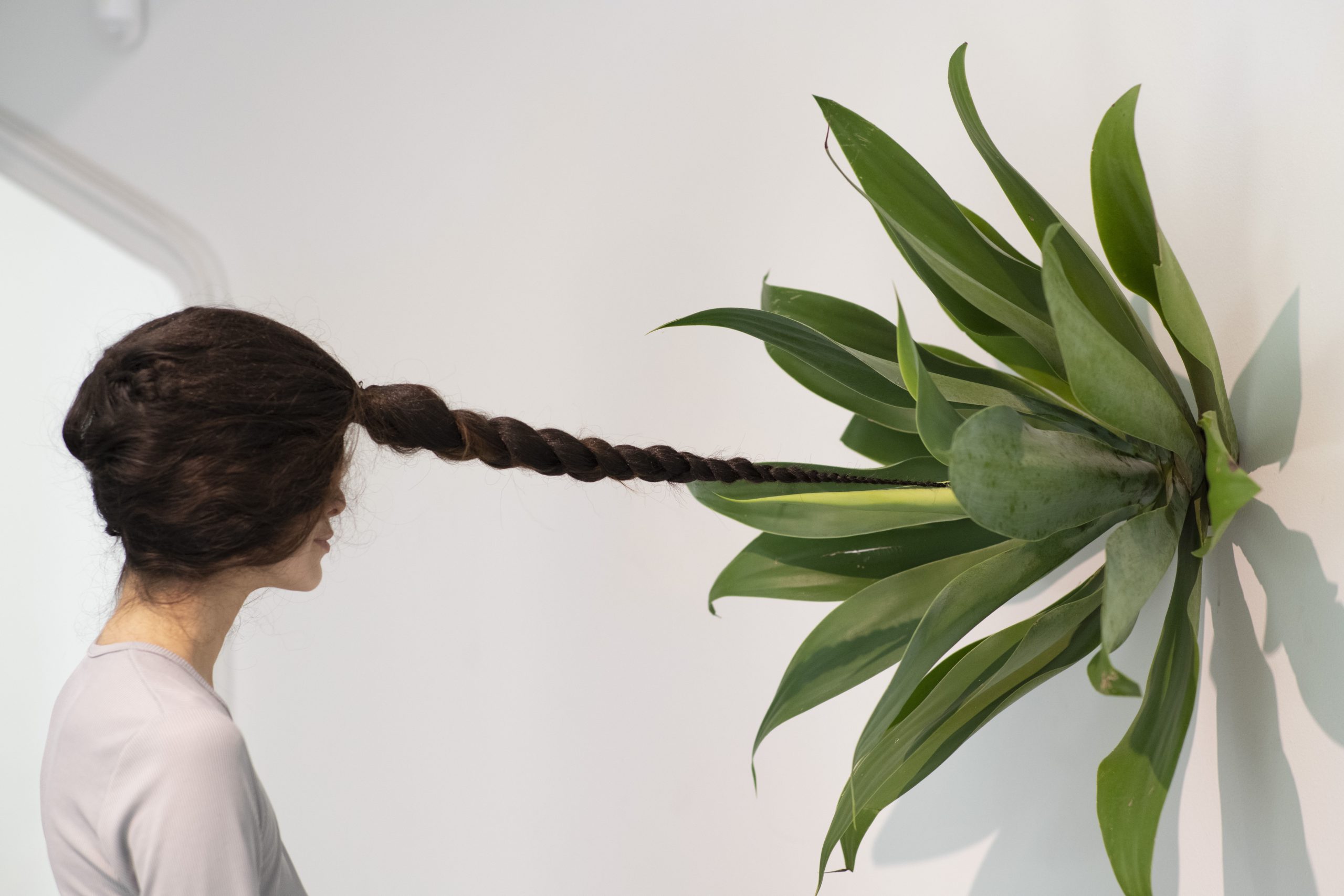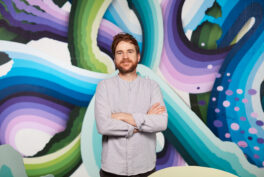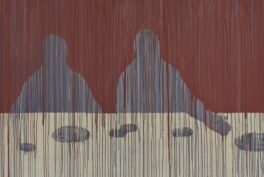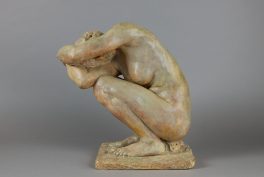Summary
Bianca Lee Vasquez, a Paris-based artist, shares her creative journey, influences, and links to archetype memory and spirituality.
Creative Roots
MP: When did you begin to identify as an artist?
BLV: In many ways, I felt I always wanted to be an artist from an early age. My mother was in charge of organizing all the plays and productions in our church. From a very young age, I was involved in some of her productions and also helped with the costumes. I think that is where I was first introduced to theater and the dramatic arts. Since I was 16, I studied theatre and dance in a specialty program in my high school. I was very religious growing up and went to church around four times a week. I think this environment surely formed me, my ideas, and the way I interact with the world. Through my practice, I find I’m always mingling with spirituality and in some ways, my art is my way of attuning to the spirit of the land. As an adult, I studied textile design at Parsons, theatre at the American Academy of Dramatic Arts, and dance at Alvin Ailey American Dance Theatre. My interests shifted around a great deal and I’m not surprised that even now I don’t stick to any one medium for very long. I never craved to be a master of an artistic medium. I’m really interested in trying new processes or mediums; getting lost and finding my way again. During these processes of discovery is where I find my integrity.
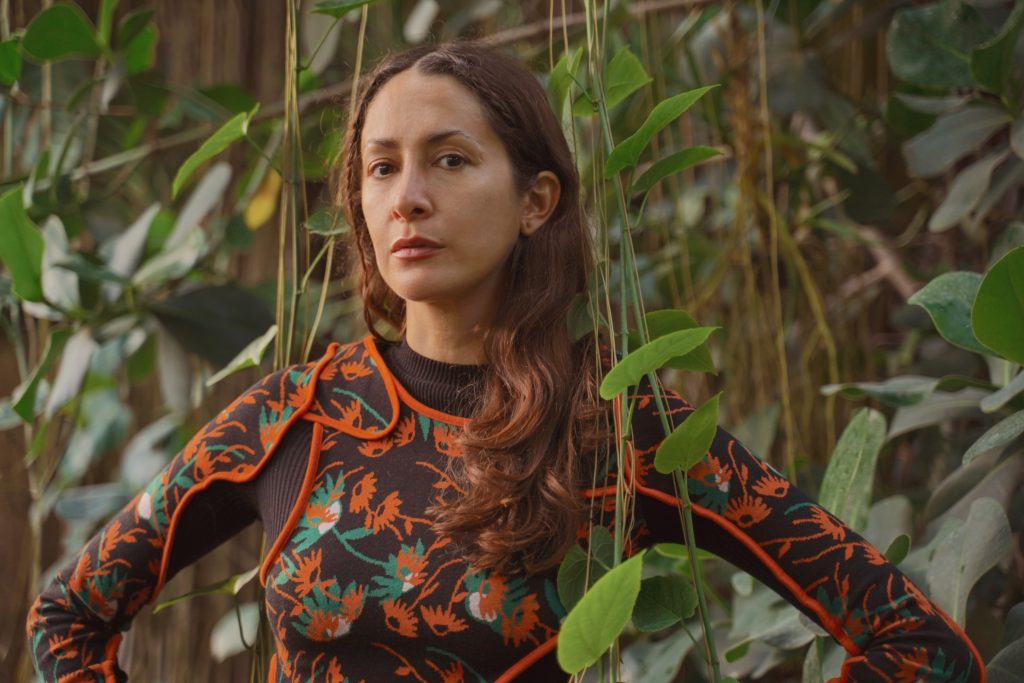
Bianca Lee Vasquez. Courtesy of the artist.
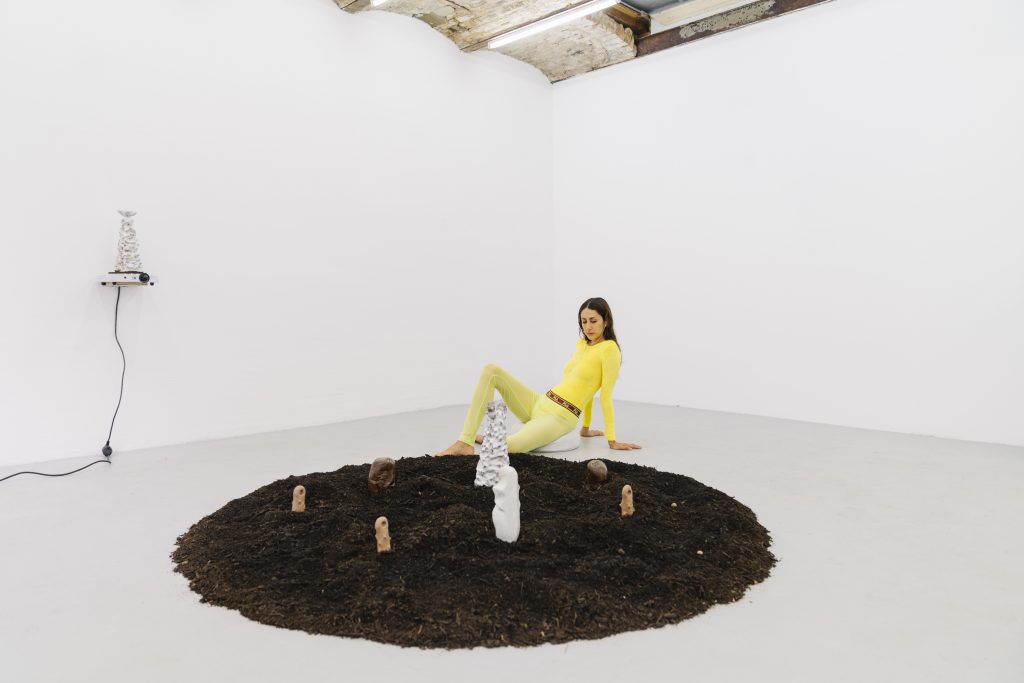
Bianca Lee Vasquez, Dirt High Series, interactive installation and performance, 2021, Interface, Berlin, Germany. Courtesy of the artist.
Natural Materials
MP: What are your favorite materials to work with and which materials are you curious to explore?
BLV: I use photography and video to document my interventions in the wild. I’m not necessarily interested in the camera itself or the technical processes. I barely know how to use a digital camera. I always opt for a simple analog. What interests me is materializing a remembrance of something more ancient and attuning to the intangibles of the natural world. I feel like that’s the true art. My photographic work is very spontaneous and impromptu. I seek ways to find new ways of being immersed in nature. These interventions or exchanges are central to my practice. The photograph at the end is just a relic of what happened. To me, life and art are inseparable. I’m always trying to create these experiences and in the past, this has always interested me more than any material. I’ve been working with earth, soil, trees, and roots for the past 15 years. Since the pandemic, I’ve been working more with material because I was obliged to stay indoors. Therefore, I started exploring with clay because it seemed most natural and it’s earth. I also explored drawing and textile and really like working with weaving.
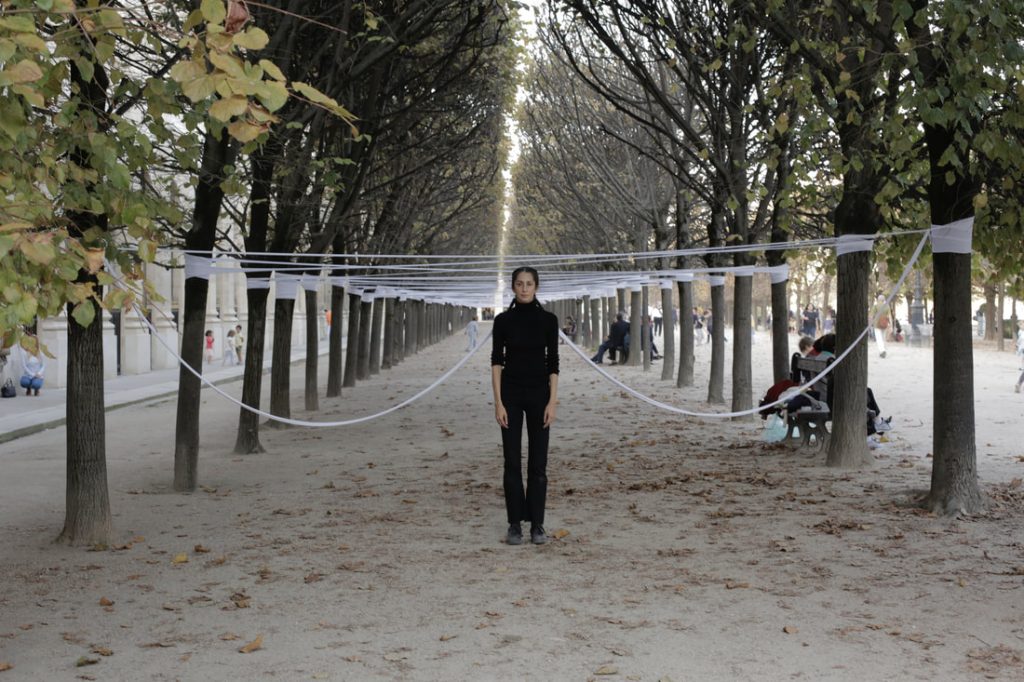
Bianca Lee Vasquez, Web Making Ritual II, performative installation, 2017, Palais Royal, Carré Latin Festival, Paris, France. Courtesy of the artist.
Web-Making Rituals
BLV: I did the first web-making ritual during a performance art residency at Centrale Fies in Northern Italy. The residency is in an old water factory, in the mountains of Dro. I was able to explore the forest around this area. It was wonderful to be able to do this residency and have the time to explore. One day, I took black yarn in my backpack and wanted to create a human-sized web. When I saw these three trees in a triangular position, I just wove a web. I can’t say exactly why I wanted to do it. Maybe I wanted to know what it was like to be truly human and be completely immersed in a web while feeling all the alive presence of the natural world. It’s really intuitive and I felt the need to do it. Often and only later can I make sense of it. A few months later, I was asked to do a performance in a public park in Paris. I wanted to develop this idea further and reimagined the same idea in Palais Royal where there’s a long alley of over 100 trees. I wanted to braid all of these trees together with 500 meters of fabric. I braided them and wanted to connect myself at the end, so I connected the fabric to the braids in my hair. To activate the performance, I then cut my braids and buried them in the ground as an offering to this land. This was a very strong work in my practice. These web-making rituals really appeal to me as being this archaic female act of weaving, whether it be braids or baskets. I think it’s something deeply embedded in our female collective unconscious. It just seems natural to work with textile and weave.
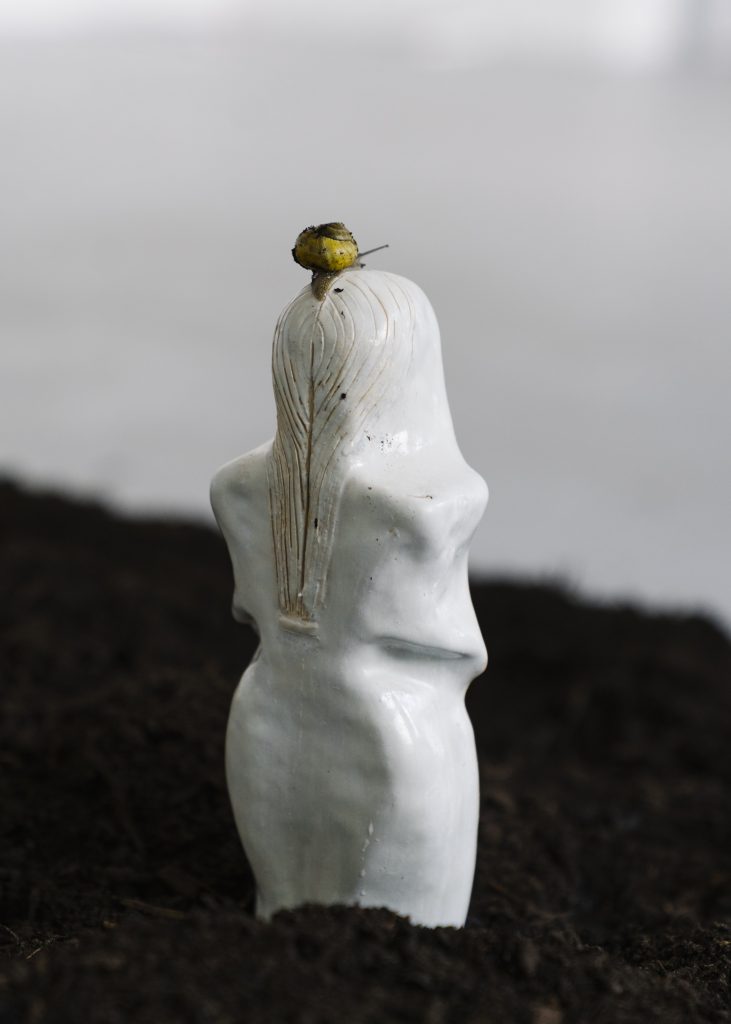
Bianca Lee Vasquez, Dirt High Series, interactive installation and performance, 2021, Interface, Berlin. Courtesy of the artist. Detail.
Practice
MP: Do you work from a studio, in situ or both?
BLV: I’ve never really worked from a studio and didn’t have one for many years. Then, I had a small space in Paris, but it was a bit far from home and without heat during the winter, so I rarely went. I would often lend the space to my painter friends because they needed a space to work more than I did. I often worked in the outdoors during walks I would take in nature, forests, and deserts. About two years ago, I got this really nice studio space in Paris and it’s changed many things for me. I’m very happy to have this space and be able to concentrate on my work while I’m there. I was often trying to work from home. It’s been a really positive change for my work that’s still very new for me.
MP: Do you seek out places to create your works?
BLV: There’s often a certain place that inspires me to do something there. For example, Skyline that I did in the south of Spain where I connected palm trees with white cloth. This was an in situ work that was just created there. I spent one month in this town called Blanca. This town has the same name as my father’s mother and for some reason, this attracted me to go there. I applied to the residency there and wanted to do something with getting to know the women of this town in homage to my grandmothers. There was a group of older women there, a theater group called Las Atrevidas meaning ”the daring ones”. They had a lot of energy and pep and are very well-known locally. They were incredibly funny, fantastic, and a pleasure to get to know. I spent every day getting to know them and learning about their lives. They brought me into their homes and shared their heartfelt stories. I did a piece where I collected white fabrics from all of these women that were meaningful to them. It was often bed sheets or napkins. Sometimes, it was the special bed sheets they first slept in after being married, which was a tradition. These fabrics were attached to the palm trees next to the river that runs through the town. What was interesting to me was creating this installation that was using this long, white fabric to draw lines in the landscape along this beautifully scenic area with a valley and a river. More than that, I wanted to connect the stories of these women and their symbolic cloths to the land and these trees, quite literally, because the trees, like all creatures, help us remember ourselves and the spirit. It wasn’t just about creating beautiful artwork but, creating links with these women and to the land. The whole process was a unique learning experience socially and emotionally for me.
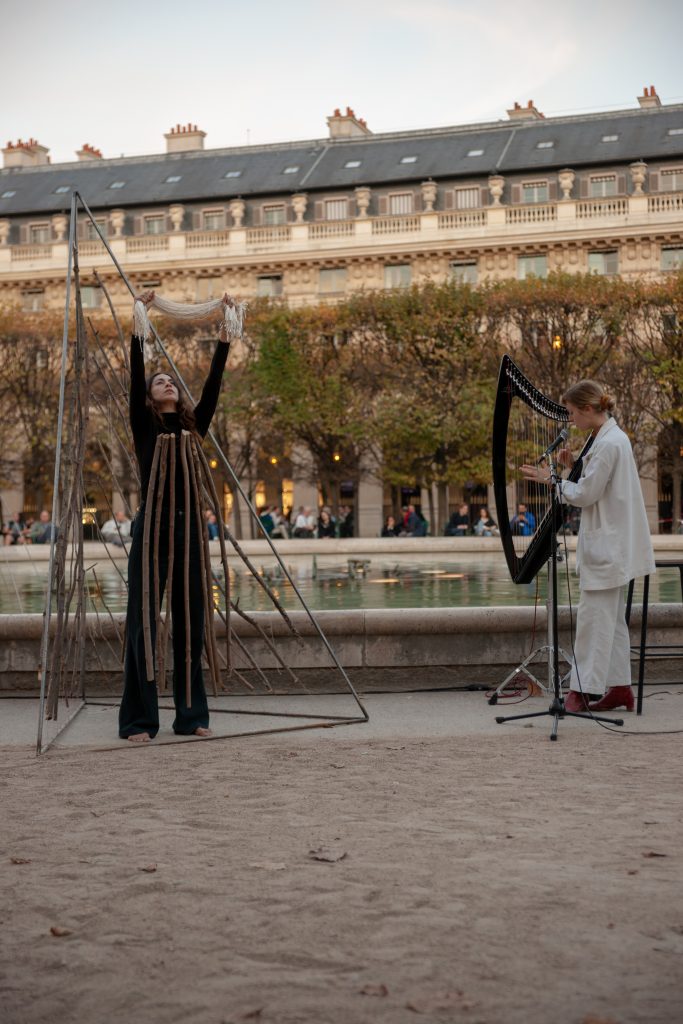
Bianca Lee Vasquez, ARPA, collaboration with musician Naomi Green, 2018, Jardin du Palais Royal, Paris, France. Courtesy of the artist.
Collaborative Works
MP: Can you share a bit about your collaborative works?
BLV: I really like collaborating with musicians and dancers. This process feeds and nurtures me and them. Creating these exchanges is most inspiring. For ARPA, I was really interested in instruments and made my own version of a harp from tree branches. This led to the collaboration with harpist Naomi Greene. I wanted to create a little world with this performance and create characters to live and function in this world. It was about creating a scenario, then being free and letting the moment just take over. This piece was completely improvised. We didn’t rehearse this performance and hadn’t even met before then. It was a really beautiful collaboration.
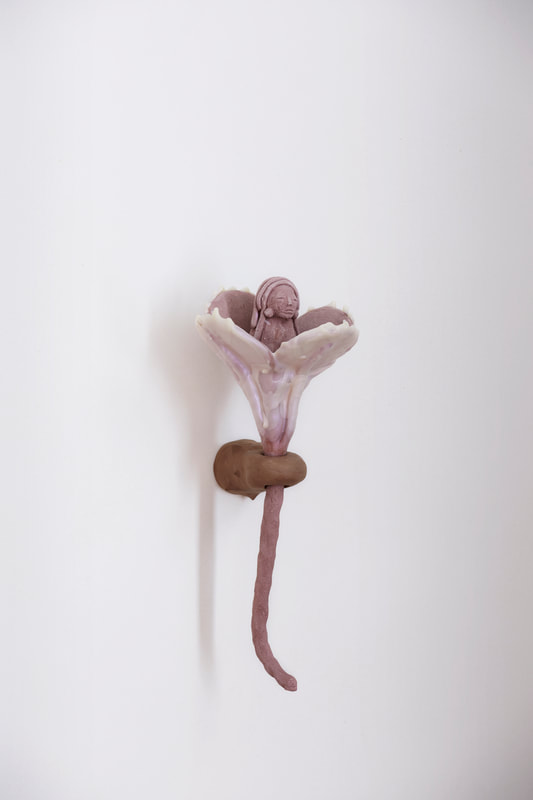
Bianca Lee Vasquez, The First Flower People, from group exhibition, Sumac Kawsay, 2020, Château de La Caze, Paris, France. Courtesy of the artist.
Challenges, Motivations, and Inspirations
MP: What challenges have you experienced as an artist?
BLV: Having the confidence and courage to put myself out there. With my early earth body works that I photographed, I didn’t have the courage to show them until years later because I had my own issues with nudity. Whether it’s because I grew up in a very religious environment or social codes, I was very uncomfortable with sharing those works. My biggest challenges come from myself, my own blocks, or parameters. I never went to art school, so sometimes I feel a bit like an imposter.
MP: What motivates you to make work and how do you stay motivated?
BLV: There are many things that I want to do that I don’t get to finish. I’m going through a big transition in my life right now and even this is giving me quite a lot of motivation and inspiration. When there’s change, it’s a catalyst for creation. I don’t need to search for motivation, it’s very natural.
MP: Inspirations?
BLV: Most of my visual language comes from my memory. Something deep inside that connects me to this genetic information connecting far back into the past, but also far ahead into the future. I also get quite inspired by people through interaction. This current work I’m working on with water was inspired by Venus and this girl with beautiful, long red hair who is the girlfriend of a dear musician friend and collaborator. Nature and music are also big inspirations.
MP: Artists you admire?
BLV: Ana Mendieta has inspired me enormously in both my artistic and personal life. She’s like this conceptual art mother in some ways. I learned about her while I was doing research for an internship with a photographer. I was so touched by her work that it really brought me to tears. She was born the same day and year as my mother. She’s also Cuban-American just like my mother and came to the US at the same age as my Mom. There was really something there that was very strong. Some of my other favorite artists are Rebecca Horn, Eva Hesse, Carolee Schneemann, Louise Bourgeois, Marisa Merz, and Marie-Ange Guilleminot.
MP: Aside from art-making, what else interests you?
BLV: I love cooking, dancing, and giving massages to my friends.
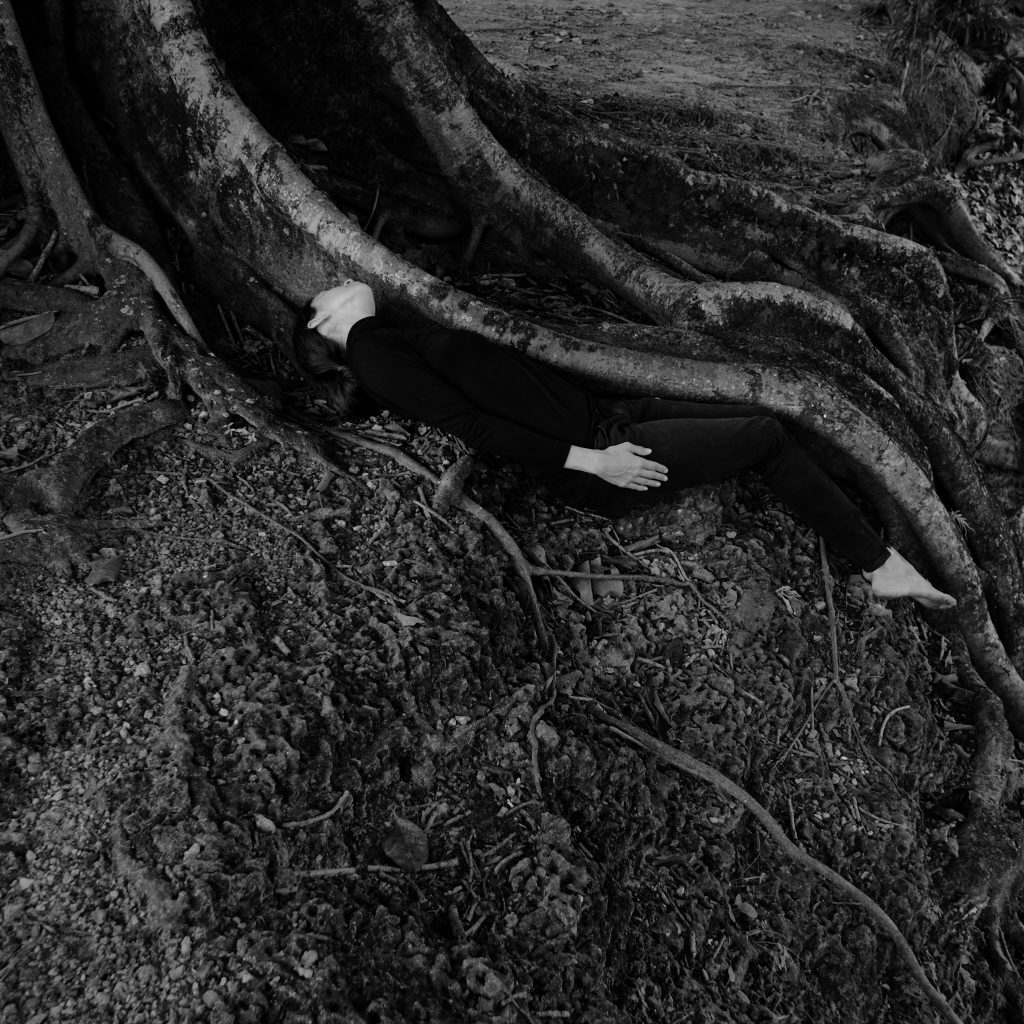
Bianca Lee Vasquez, Axis Mundi, 2016, Miami, FL, USA. Courtesy of the artist.
Nature vs. City
MP: How did your relationship with nature develop?
BLV: In the Sierra mountains of Ecuador on my Dad’s farm in Cotopaxi. I remember being alone on a horse without a saddle on the side of the mountains. I think I was 11 or 12. Playing with rocks instead of dolls. I remember seeing these incredible views of the landscape, exploring the mountain, and really felt taken by the wildness of nature and its beauty. I learned very early on that the natural world is a world of alive presence.
MP: How does where you live affect your artwork?
BLV: Where I live definitely affects what I’m making. Living in the city, I work more from my studio, creating more sculptures and material works. If I lived in the countryside, I’d be outside much more and doing something else.
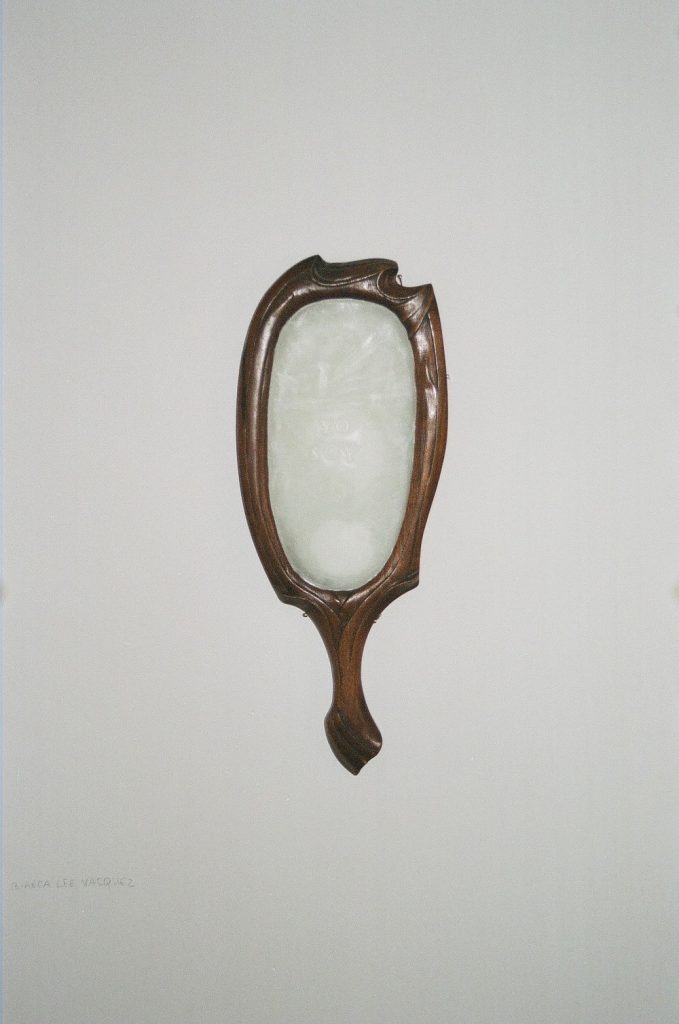
Bianca Lee Vasquez, Naturaleza, carved wood and wax, 2020. Courtesy of the artist.
Artist as Gallerist
MP: How did Sainte Anne Gallery come to be and how are you involved?
BLV: This is a project with one of my best friends, Masha Novoselova. We had this idea for an artist-run space and started it last year. It’s been a really wonderful opportunity to create community and have an exhibition space to show the work of our circle of artist friends around us. It’s also an opportunity to meet and show works of artists we admire. It’s been a really beautiful experience and a great project that I’m really happy with. To be honest, I was hesitant at first because I never wanted to be part of this commercial aspect of the art world. I’m not interested in being a player in this capitalist system. What made me change my mind in the end was the fact that this system isn’t going away just yet, so I’d rather be part of it and turn it in my favor to propose things that are more relevant or worth considering. We show artworks that we’re passionate about.
MP: Do you find the contemporary art world in Paris is supportive of emerging artists?
BLV: I think it is. Paris has become the new art capital in the last few years. There are many contemporary art hubs like Poush Manifesto and big office buildings that are giving inexpensive spaces to artists to work and have studios. This has definitely helped artists. France is also a country that supports the arts, especially cinema. Unfortunately, not the fine arts as much.
MP: Do you feel that you’re part of a creative community in Paris?
BLV: I’ve created my own. It’s quite important. I’m not the type of artist who wants to be alone in a studio all day. I’m an artist that is actively working, collaborating, and helping others create. I have many friends who help me do all sorts of things, so it’s about this exchange which is really nice.
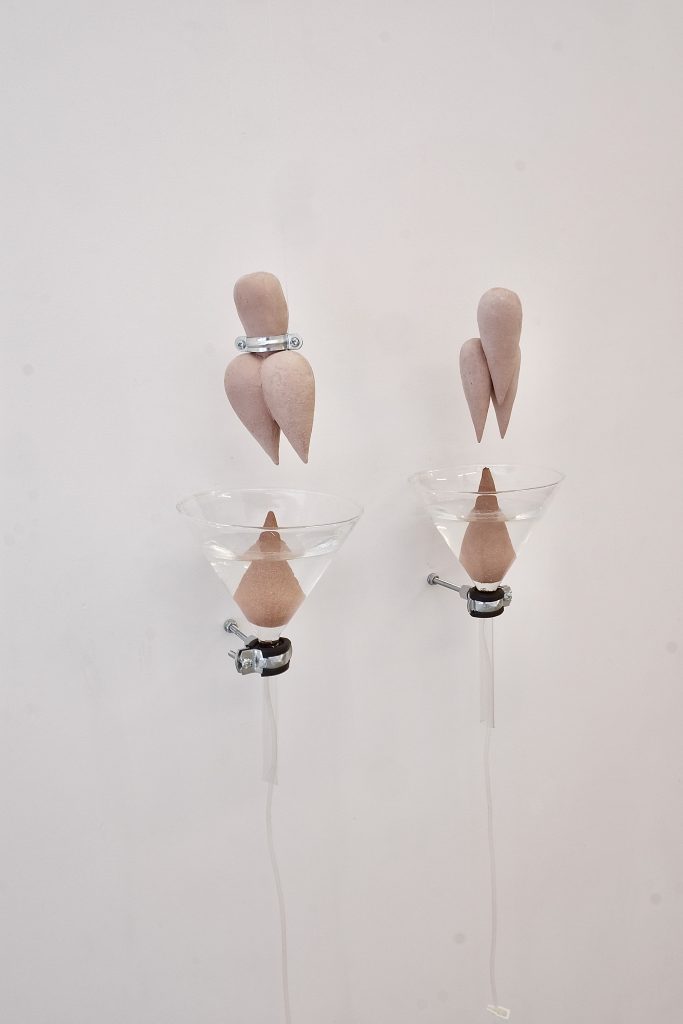
Bianca Lee Vasquez, Take Me To My Watery Beginnings, 2022. Courtesy of the artist.
New and Future Work
MP: Can you talk about your recent piece, Take Me To My Watery Beginnings?
BLV: This is the first interactive sculpture I’ve done. It’s a kinetic water sculpture with the potential to make you feel the intangibles. There’s an IV tube that’s connected to this glass vessel of water and you can connect the IV to your belly button. There’s a water drip. It acts as a refresh to our aquatic, prenatal memory or maybe to a memory much further back than our own births, like the watery beginnings of pre-terrestrial life. I like to propose this meditative process to people to connect to some watery memory, possibly also healing.
MP: Any exhibitions on the horizon?
BLV: In Paris, I’m currently showing Beating Agua, an aquatic dress, and some new sculptural works in a group exhibition, Terra Mater curated by Marilou Thirache. I’m also part of the group show by Sophie Strobele, Moria, where I’ll show a new glass sculpture piece inspired by the thread-like nature of adventitious roots. I have an upcoming show, Fire, curated by Manuel Gomez in October.
Bianca Lee Vasquez is Cuban-American-Ecuadoran raised in Miami, Florida. She lives and works in Paris, France. Her desire to connect and grow as an artist has led to a handful of unique collaborations rooted in performance and ritual. Vasquez’s endless curiosity enhances her art practice, enabling her to explore new ways of connecting and creating art. Often working with natural materials outside and in situ, her work reminds us the earth and our bodies are one.
Peek into the world of Bianca Lee Vasquez here:
